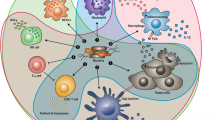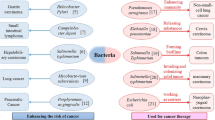Abstract
One of the primary limitations of cancer therapy is lack of selectivity of therapeutic agents to tumor cells. Current efforts are focused on discovering and developing anticancer agents that selectively target only tumor cells and spare normal cells to improve the therapeutic index. The use of preferentially replicating bacteria as an oncolytic agent is one of the innovative approaches for the treatment of cancer. This is based on the observation that some obligate or facultative anaerobic bacteria are capable of multiplying selectively in tumors and inhibiting their growth. Meanwhile, bacteria have been demonstrated to colonize and destroy tumor, and have emerged as biological gene vectors to tumor microenvironment. To improve the efficacy and safety of the bacterial therapy, a further understanding of bacteria between with immune system is required. Furthermore, we want to evaluate how bacterial infection facilitates the “bystander effect” of chemotherapeutic agent and assess if it can be used for additional antitumor effect when combined with chemotherapy. This study may not only evaluate therapeutic efficacy of bacteria for the treatment of cancer but also elucidate the mechanisms underlying antitumor activities mediated by bacteria, which involve host immune responses and the cellular molecular responses.


Similar content being viewed by others
References
Avogadri F, Mittal D, Saccheri F, Sarrafiore M, Ciocca M, Larghi P, Orecchia R, Rescigno M (2008) Intra-tumoral Salmonella typhimurium induces a systemic anti-tumor immune response that is directed by low-dose radiation to treat distal disease. Eur J Immunol 38:1937–1947
Boise LH, Collins CM (2001) Salmonella-induced cell death: apoptosis, necrosis or programmed cell death? Trends Microbiol 9:64–67
Brown JM, Giaccia AJ (1998) The unique physiology of solid tumors: opportunities (and problems) for cancer therapy. Cancer Res 58:1408–1416
Chen LM, Kaniga K, Galán JE (1996) Salmonella spp. are cytotoxic for cultured macrophages. Mol Microbiol 21:1101–1115
Chen G, Wei DP, Jia LJ, Tang B, Shu L, Zhang K, Xu Y, Gao J, Huang XF, Jiang WH, Hu QG, Huang Y, Wu Q, Sun ZH, Zhang JF, Hua ZC (2009) Oral delivery of tumor-targeting Salmonella exhibits promising therapeutic efficacy and low toxicity. Cancer Sci 100:2437–2443
Clairmont C, Lee KC, Pike J, Ittensohn M, Low KB, Pawelek J, Bermudes D, Brecher SM, Margitich D, Turnier J, Li Z, Luo X, King I, Zheng LM (2000) Biodistribution and genetic stability of the novel antitumor agent VNP20009, a genetically modified strain of Salmonella typhimurium. J Infect Dis 181:1996–2002
Cronin M, Morrissey D, Rajendran S, Mashad SMEI, Sinderen DV, O’Sullivan GC, Tangney M (2010) Orally administered bifidobacteria as vehicles for delivery of agents to systemic tumors. Mol Ther 18:1397–1407
Dang LH, Bettegowda C, Huso DL, Kinzler KW, Vogelstein B (2001) Combination bacteriolytic therapy for the treatment of experimental tumors. Proc Natl Acad Sci U S A 98:15155–15160
Engelbart K, Gericke D (1964) Oncolysis by Clostridia. V. Transplanted tumors of the hamster. Cancer Res 24:239–242
Folkman J, Watson K, Ingber D, Hanahan D (1989) Induction of angiogenesis during the transition from hyperplasia to neoplasia. Nature 339:58–61
Forbes NS, Munn LL, Fukumura D, Jain RK (2003) Sparse initial entrapment of systemically injected Salmonella typhimurium leads to heterogeneous accumulation within tumors. Cancer Res 63:5188–5193
Fox ME, Lemmon MJ, Mauchline ML, Davis TO, Giaccia AJ, Minton NP, Brown JM (1996) Anaerobic bacteria as a delivery system for cancer gene therapy: in vitro activation of 5-fluorocytosine by genetically engineered Clostridia. Gene Ther 3:173–178
Ganai S, Arenas RB, Sauer JP, Bentley B, Forbes NS (2011) In tumors Salmonella migrate away from vasculature toward the transition zone and induce apoptosis. Cancer Gene Ther 18:457–466
Graeber TG, Osmanian C, Jacks T, Housman DE, Koch CJ, Lowe SW, Giaccia AJ (1996) Hypoxia-mediated selection of cells with diminished apoptotic potential in solid tumours. Nature 379:88–91
Hernandez LD, Pypaert M, Flavell RA, Galán JE (2003) A Salmonella protein causes macrophage cell death by inducing autophagy. J Cell Biol 163:1123–1131
Kimura NT, Taniguchi S, Aoki K, Baba T (1980) Selective localization and growth of Bifidobacterium bifidum in mouse tumors following intravenous administration. Cancer Res 40:2061–2068
King I, Bermudes D, Lin S, Belcourt M, Pike J, Troy K, Le T, Ittensohn M, Mao J, Lang W, Runyan JD, Luo X, Li Z, Zheng LM (2002) Tumor-targeted Salmonella expressing cytosine deaminase as an anticancer agent. Hum Gene Ther 13:1225–1233
Kirkegaard K, Taylor MP, Jackson WT (2004) Cellular autophagy: surrender, avoidance and subversion by microorganisms. Nat Rev Microbiol 2:301–314
Lee CH, Wu CL, Shiau AL (2004) Endostatin gene therapy delivered by Salmonella choleraesuis in murine tumor models. J Gene Med 6:1382–1393
Lee CH, Wu CL, Shiau AL (2005a) Systemic administration of attenuated Salmonella choleraesuis carrying thrombospondin-1 gene leads to tumor-specific transgene expression, delayed tumor growth and prolonged survival in the murine melanoma model. Cancer Gene Ther 12:175–184
Lee CH, Wu CL, Tai YS, Shiau AL (2005b) Systemic administration of attenuated Salmonella choleraesuis in combination with cisplatin for cancer therapy. Mol Ther 11:707–716
Lee CH, Wu CL, Shiau AL (2008a) Salmonella choleraesuis as an anticancer agent in a syngeneic model of orthotopic hepatocellular carcinoma. Int J Cancer 122(4):930–935
Lee CH, Wu CL, Shiau AL (2008b) Toll-like receptor 4 mediates an antitumor host response induced by Salmonella choleraesuis. Clin Cancer Res 14:1905–1912
Lee CH, Wu CL, Chen SH, Shiau AL (2009) Humoral immune responses inhibit the antitumor activities mediated by Salmonella enterica serovar choleraesuis. J Immunother 32:376–388
Lee CH, Hsieh JL, Wu CL, Hsu HC, Shiau AL (2011a) B cells are required for tumor-targeting Salmonella in host. Appl Microbiol Biotechnol doi:10.1007/s00253-011-3386-0
Lee CH, Hsieh JL, Wu CL, Hsu PY, Shiau AL (2011b) T cell augments the antitumor activity of tumor-targeting Salmonella. Appl Microbiol Biotechnol 90:1381–1388
Li X, Fu GF, Fan YR, Liu WH, Liu XJ, Wang JJ, Xu GX (2003) Bifidobacterium adolescentis as a delivery system of endostatin for cancer gene therapy: selective inhibitor of angiogenesis and hypoxic tumor growth. Cancer Gene Ther 10:105–111
Low KB, Ittensohn M, Le T, Platt J, Sodi S, Amoss M, Ash O, Carmichael E, Chakraborty A, Fischer J, Lin SL, Luo X, Miller SI, Zheng L, King I, Pawelek JM, Bermudes D (1999) Lipid A mutant Salmonella with suppressed virulence and TNF α induction retain tumor-targeting in vivo. Nat Biotechnol 17:37–41
Manuel ER, Blache CA, Paquette R, Kaltcheva TI, Ishizaki H, Ellenhorn JD, Hensel M, Metelitsa L, Diamond DJ (2011) Enhancement of cancer vaccine therapy by systemic delivery of a tumor-targeting Salmonella-based STAT3 shRNA suppresses the growth of established melanoma tumors. Cancer Res 71:4183–4191
Mei S, Theys J, Landuyt W, Anne J, Lambin P (2002) Optimization of tumor-targeted gene delivery by engineered attenuated Salmonella typhimurium. Anticancer Res 22:3261–3266
Nemunaitis J, Cunningham C, Senzer N, Kuhn J, Cramm J, Litz C, Cavagnolo R, Cahill A, Clairmont C, Sznol M (2003) Pilot trial of genetically modified, attenuated Salmonella expressing the E. coli cytosine deaminase gene in refractory cancer patients. Cancer Gene Ther 10:737–744
Nuyts S, Van Mellaert L, Theys J, Landuyt W, Bosmans E, Anne J, Lambin P (2001) Radio-responsive recA promoter significantly increases TNF α production in recombinant clostridia after 2 Gy irradiation. Gene Ther 8:1197–1201
Pawelek JM, Low KB, Bermudes D (1997) Tumor-targeted Salmonella as a novel anticancer vector. Cancer Res 57:4537–4544
Pawelek JM, Low KB, Bermudes D (2003) Bacteria as tumour-targeting vectors. Lancet Oncol 4:548–556
Rosenberg SA, Spiess PJ, Kleiner DE (2002) Antitumor effects in mice of the intravenous injection of attenuated Salmonella typhimurium. J Immunother 25:218–225
Saccheri F, Pozzi C, Avogadri F, Barozzi S, Faretta M, Fusi P, Rescigno M (2010) Bacteria-induced gap junctions in tumors favor antigen cross-presentation and antitumor immunity. Sci Transl Med 2:44ra57
Soghomonyan SA, Doubrovin M, Pike J, Luo X, Ittensohn M, Runyan JD, Balatoni J, Finn R, Tjuvajev JG, Blasberg R, Bermudes D (2005) Positron emission tomography (PET) imaging of tumor-localized Salmonella expressing HSV1-TK. Cancer Gene Ther 12:101–108
Sorenson BS, Banton KL, Frykman NL, Leonard AS, Saltzman DA (2008) Attenuated Salmonella typhimurium with interleukin 2 gene prevents the establishment of pulmonary metastases in a model of osteosarcoma. J Pediatr Surg 43:1153–1158
Sznol M, Lin SL, Bermudes D, Zheng LM, King I (2000) Use of preferentially replicating bacteria for the treatment of cancer. J Clin Invest 105:1027–1030
Thiele EH, Arison RN, Boxer GE (1964) Oncolysis by Clostridia. IV. Effect of nonpathogenic clostridial spores in normal and pathological tissues. Cancer Res 24:234–238
Toso JF, Gill VJ, Hwu P, Marincola FM, Restifo NP, Schwartzentruber DJ, Sherry RM, Topalian SL, Yang JC, Stock F, Freezer LJ, Morton KE, Seipp C, Haworth L, Mavroukakis S, White D, MacDonald S, Mao J, Sznol M, Rosenberg SA (2002) Phase I study of the intravenous administration of attenuated Salmonella typhimurium to patients with metastatic melanoma. J Clin Oncol 20:142–152
Westphal K, Leschner S, Jablonska J, Loessner H, Weiss S (2008) Containment of tumor-colonizing bacteria by host neutrophils. Cancer Res 68:2952–2960
Yazawa K, Fujimori M, Nakamura T, Sasaki T, Amano J, Kano Y, Taniguchi S (2001) Bifidobacterium longum as a delivery system for gene therapy of chemically induced rat mammary tumors. Breast Cancer Res Treat 66:165–170
Yu YA, Shabahang S, Timiryasova TM, Zhang Q, Beltz R, Gentschev I, Goebel W, Szalay AA (2004) Visualization of tumors and metastases in live animals with bacteria and vaccinia virus encoding light-emitting proteins. Nat Biotechnol 22:313–320
Acknowledgments
This work was supported by grants from National Science Council (NSC 100-2320-B-039-024) and China Medical University (CMU-99-N2-08).
Conflict of interest
The author declares that he has no conflict of interests.
Author information
Authors and Affiliations
Corresponding author
Rights and permissions
About this article
Cite this article
Lee, CH. Engineering bacteria toward tumor targeting for cancer treatment: current state and perspectives. Appl Microbiol Biotechnol 93, 517–523 (2012). https://doi.org/10.1007/s00253-011-3695-3
Received:
Revised:
Accepted:
Published:
Issue Date:
DOI: https://doi.org/10.1007/s00253-011-3695-3




